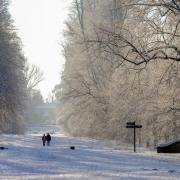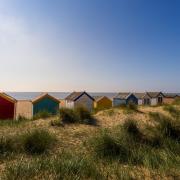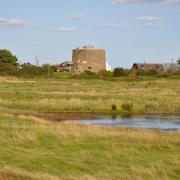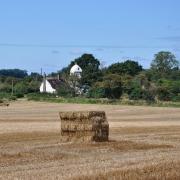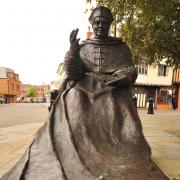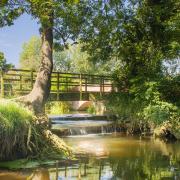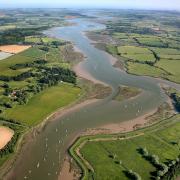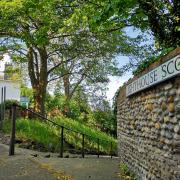Nothing could be easier than falling in love with Suffolk. Its countryside is such a natural partner – breathtakingly beautiful, quaintly quirky and wonderfully wedded to the seasons.

Take a winter walk along unexpected bridleways through the heart of Bungay, where holly boughs cosy up to Bigods castle and winding ways unveil some rural hilltop vistas. Mooch around Framlingham Mere for close encounters with an occasional egret, cormorant and even a kissing gate or two.
Discover how Dunwich is ideal for an early spring smooch down Lovers Lane, through ancient woodlands past the drifts of snowdrops, en route to the romantic clifftop ruins of the old Greyfriars priory. Then there’s the bridleway by the old abbey remains, leading from Leiston’s Lovers Lane to the wetlands and wildflower meadows of Sizewell Belts.
Head out with the first calls of the cuckoo to admire the delicate white Lady’s Smock, or hide up near the reedy marshes to listen out for a booming bittern. Thanks to the unexpected broadleaf, conifer and rhododendron mix, there’s a wonderfully colourful waddle to be had here at any time of the year around Goose and Kenton Hills. Well, they do say that what’s sauce for the goose, is sauce for the gander...
Something old

Ah, those idyllic Stour Valley views. Those timeless Suffolk borderland vistas immortalised by Constable seem to stretch for miles and miles, when you’re out there on foot. Few Suffolk strolls could be more romantic than a walk hand-in-hand with history along those Stour-side paths which lead through lazy, time-honoured lands of iridescent damsel and dragonflies, and glidingly elegant swans.
From Flatford’s classic Haywain setting to delightful Dedham with its magical collection of equine inspired paintings at the Munnings Art Museum, it’s dreamy stuff.
Suffolk born and bred, Sir Alfred Munnings was a Waveney lad, so when he and his easel hit the equine saddle in the late 1800s, his travels took him around the hauntingly historic area of meadows and farmsteads known as The Saints. Explore on your own four-legged or two-wheeled steed with the 26-mile circular Munnings Trail between Halesworth and Bungay, or check out the five-mile circular Waveney Valley walk suggested opposite the Sir Alfred Munnings pub in Mendham. Leading north along the Angles Way, it curls round to Sconch Beck and the beautiful valley of St Cross South Elmham, before heading back to the village past Weston House Farm and Walsham Hall, along footpaths, bridleways and byways. For a really romantic treat, and secret find, detour down the footpaths from New Road to discover the ruins of South Elmham Minster. The historic farm here is one of Suffolk’s few remaining havens for rare turtle doves.

Something new
Well new-ish. Newmarket, the capital of horseracing, owes its existence to a dowry dating back to 1200 AD when local lass Cassandra, the daughter of Exning’s Lord of the Manor, married Sir Richard de Argentein. On the site of the ancient Icknield Way, Newmarket fast gathered permissions for weekly markets and annual fairs and soon attracted wealth and interest from all over, especially for its local hunting grounds.
Walk out along Devils Dyke, the Anglo-Saxon earthwork with outstanding racecourse views. Watch the horses warm up on The Severals or head up to the heath to feel the earth move as they go galloping by. From nearby Moulton with its packhorse bridge, from Gazeley and Barrow, these eight or nine-mile Newmarket Ride routes are explorations full of new discoveries, which are simply great by bike, on horseback or equally enjoyable on foot. Incorporating small lanes, bridleways and even the ancient Icknield Way path, there’s a certain romantic spirit of adventure as your find yourself trying to unravel the tales behind Bluebutton Wood, Dalhams Opposition Mill, Castle Holes, Nutmeg Hall and the Swiss stained glass of St Andrews Great Saxham.
Something borrowed
Stories, just like superstitions, seem to get handed down from generation to generation. In Hoxne, wedding parties still detour for miles to avoid bad luck brought by crossing Goldbrook Bridge, a place cursed since the day King Edmund hid underneath it from the Vikings and was betrayed by an otherwise potentially happy couple. It’s probably all just idle hearsay.
Over towards the coast, many an old wives tale surely graced the Sailors’ Path from Snape to Aldeburgh when local mawthers made their daily way to jobs at the laundry. No doubt as they passed by the blushing heather and sweet coconut scents of Snape Warren, burly sailors sharing the same route would have keenly reminded them that when gorse is in flower, kissing is in season. These days a kissing gate greets you on arrival at the Warren and both the heathland and the six-mile path leading from Snape Bridge via woodlands, marshes and heaths to Aldeburgh beach feature very well-signposted trails.
Something blue
Spouses Vale near Assington in late spring – alongside Arger Fen it makes the most magical carpet of blue, a place where ancient woodlands wrapped in silky bluebell shimmers simply transport you out of this world. The little blue trail gives a taste of the dream, the 2.5-mile black trail delivers the full monty. Ultimately all it takes is a Suffolk blue sky day and every inch of the county’s countryside becomes a special treasure. Who needs a bouquet when there’s a hedge full of briar roses? What could be a more perfect bridleway than a tunnel of May blossom that colours the world so delicately with its confetti of petals? Step out into the Suffolk countryside and chances are, you’ll not just fall in love – you’ll vow to do it again and again.
Bridal ways
You’ll find charming half-timbered houses and quaint streets named Bridewell in Woodbridge, Clare and Bury. Named after London’s St Brides Well prison, it denotes the site of a 16th century house of correction. One Suffolk bride who didn’t fare too well was Catherine Foster from Acton near Long Melford. Found guilty of bumping off her new husband with an arsenic-laced dumpling, she was the last woman to face public execution in Bury St Edmunds (1846).
Find out more
Local Tourist Information Centres or www.discoversuffolk.org.uk will tell you more about countryside access and Suffolk’s great network of footpaths, bridleways and byways including a great selection of leaflets for self-guided walks and rides.










